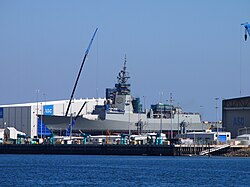| Osborne Naval Shipyard | |
|---|---|
 View of shipyard from the Port River | |
 | |
| Location | Osborne, Adelaide |
| Coordinates | 34°47′06″S138°30′40″E / 34.785°S 138.511°E |
| Industry | Naval Shipbuilding |
| Products | Royal Australian Navy ships |
| Owner | Australian Naval Infrastructure (ANI) [1] |
The Osborne Naval Shipyard is a Royal Australian Navy multi-user ship construction facility on the Lefevre Peninsula at Osborne, South Australia. It is the most advanced shipbuilding facility in both Australia and the Southern Hemisphere, and has produced several classes of major surface combatants and submerged vessels, such as destroyers, frigates, patrol boats and submarines for the Royal Australian Navy fleet.
Contents
The facility was established by the direction of the Australian government in 1987 for the Australian Submarine Corporation in order to construct the six Collins-class submarines. Since then, it has expanded significantly, incorporating a vast array of technology and facilities as the main supplier of naval vessels for the RAN. The Osborne Naval Shipyard is widely regarded as one of the most technologically advanced naval shipbuilding facilities in the world, with "digital twin" ship building methods. The shipyard will be the location for the construction of the SSN-AUKUS submarines from the 2030s onwards, as the primary manufacturing hub of the trilateral AUKUS security pact. The facility currently administers Collins-class submarine full-cycle docking and 'Life of Type' extension program and the Hunter-class frigate program.
As of 2025, significant expansions of the facility are in progress in order to triple the size of the shipyard to accommodate SSN-AUKUS submarine construction activities. Once completed, the facility will be one of only a handful across the world which will have the capacity to produce large surface combatant vessels and nuclear-powered submarines simultaneously. According to preliminary plans for the new shipyard, Osborne will receive a third shiplift and potentially a graving dock to the north of the site for construction and maintenance of SSN-AUKUS submarines. [2] [3]


